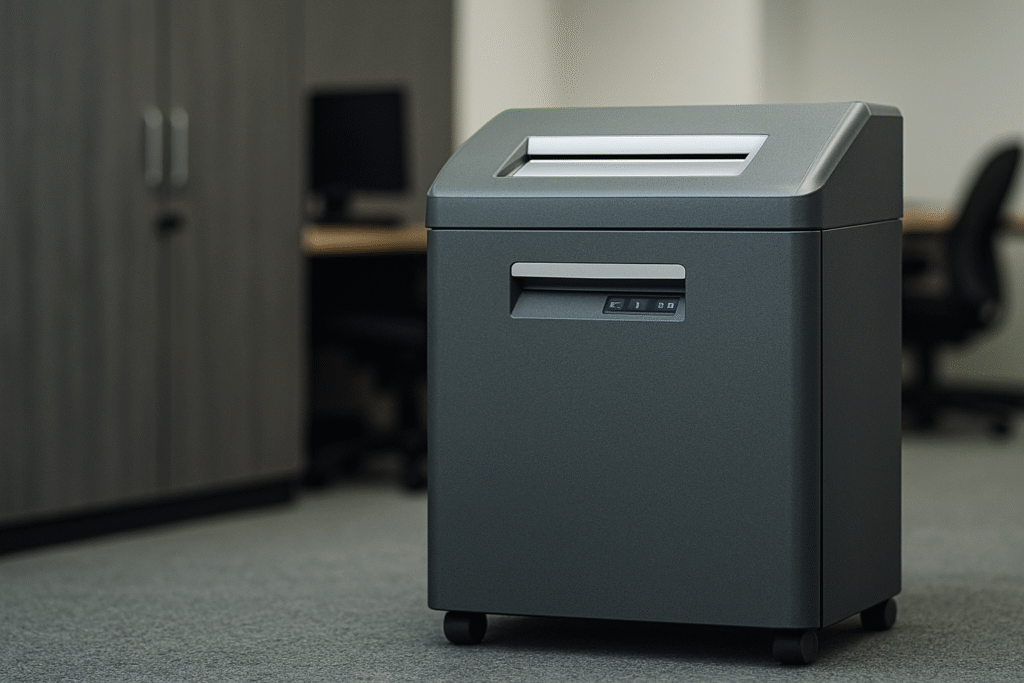Heavy duty paper shredders offer a powerful way to destroy large volumes of confidential documents quickly and securely. Ideal for offices, institutions, and businesses, these machines provide high-capacity shredding, fast operation, and strong security—all while saving time and money.
Why choose a heavy duty paper shredder?
Heavy duty shredders stand out for their ability to handle high-volume shredding with ease. They often use rideconveyor feeds, tough cutting mechanisms, and long run‑times without overheating.
These shredders shred not only paper, but also credit cards, CDs, DVDs, and even light cardboard. Many models reach security levels P‑4 or higher, which meets standards for sensitive and regulated information.
Key advantages
- Speed and capacity
Commercial units shred dozens—or even hundreds—of sheets per minute. Industrial machines can handle pallets of documents at once. - Robust security
Levels P‑4 to P‑6 ensure shredded pieces are too small to reconstruct, protecting client data and meeting compliance needs. - Durability and uptime
These units run for long periods—even continuously—with minimal cool‑down. That means no more waiting or interrupted tasks en.wikipedia.orgbusiness.org - Cost savings
Investing in a heavy duty shredder cuts the recurring cost of external destruction services, often paying for itself within months. - Eco‑friendly disposal
Shredded paper can be recycled more efficiently, reducing landfill and supporting sustainability goals.

Who needs one?
- Large offices shredding hundreds of pages daily
- Healthcare providers handling patient files
- Financial institutions processing bank statements
- Factories or warehouses disposing of manuals, packaging, or labels
- Schools removing student records in bulk
If your business generates high volumes of paper or sensitive materials, a heavy duty shredder is a smart investment.
Types of heavy duty shredders
- Commercial (office-grade)
- Feed 20–40 sheets per pass
- Moderate bin size, quieter motors
- Ideal for mid‑sized teams
- Industrial
- Shred hundreds of sheets or pallets at once
- Conveyor systems, automatic feeds, multi-shaft cutters
- Built to run 24/7 without overheating
Choice depends on shredding volume: offices find commercial models sufficient, while warehouses or services need industrial solutions.
Buying tips
- Sheet capacity: Estimate daily volume. For heavy use, gear toward 40‑100 sheets per load or conveyor feed.
- Run time: Go for units that support 30+ minutes continuous operation.
- Security rating: For private data, choose P‑4 or P‑5.
- Extras: Auto‑reverse to clear jams, oiling systems for smoother cutting, casters for mobility.
Using a heavy duty shredder
- Prep materials: Remove large clips or binders unless the model accepts them.
- Load carefully: Even top-tier units have limits—feed evenly to avoid jams.
- Empty bins regularly: Larger bins help, but checking before overflow is wise.
- Maintain blades: Use shredder oil or sheets to keep cutters sharp and prevent wear.
- Stay safe: Keep hands and loose clothing away from entry points. Many machines include safety sensors.
Comparing common models
| Use case | Recommended model | Highlights |
|---|---|---|
| Mid‑sized office | Bonsaii C144-D (20‑sheet, 40‑min run) | Quiet, reliable, handles cards/CDs |
| Large office | Ideal 3104 (14–17 sheet with 32-gal bin) | High bin, German‑made durability |
| Industrial settings | MBM Destroyit 4002SC strip-cut | Conveyor feed, auto oil, heavy materials |
Maintenance & best practices
- Daily: Empty bin when 75% full, inspect feed area
- Weekly: Run oil sheet or apply lubricant directly
- Monthly: Clean blades, tighten any loose parts
- Annually: Service belts or motors, calibrate sensors
Following a schedule ensures smooth operation and helps extend lifespan.
Avoid these common mistakes
- Overloading can hike wear or jam cutters
- Ignoring oiling leads to slowed cutting
- Using in cramped areas increases risk and noise
- Mixing hazardous materials (like batteries or food) can damage components
Conclusion
Heavy duty paper shredders are ideal for environments where large amounts of confidential material require fast, reliable destruction. They save time, cut costs, and protect privacy—all while supporting recycling efforts. For offices shredding daily, or industries with secure data, these machines are essential.
Think about your volume and security needs, and match them with run time, shred size, and machine features. With proper upkeep, a high‑capacity shredder will serve your operation well for years.
